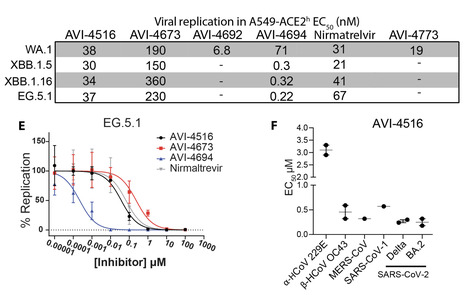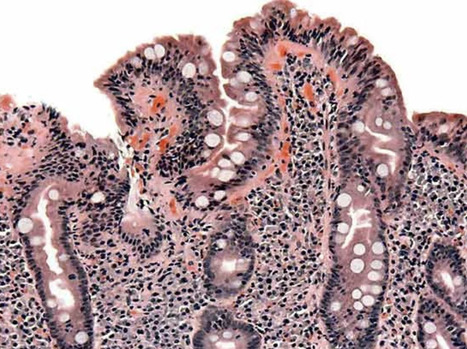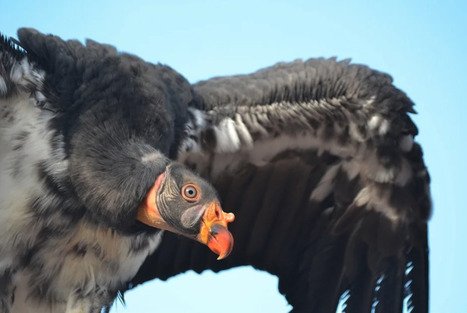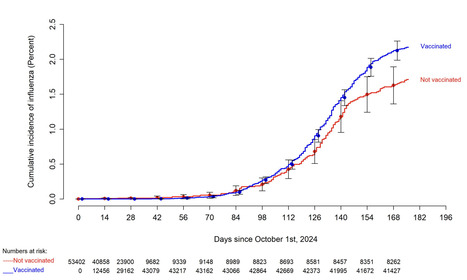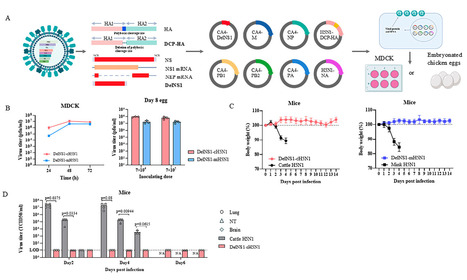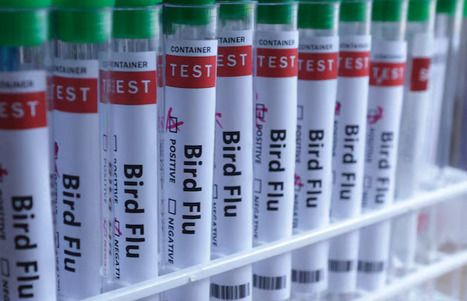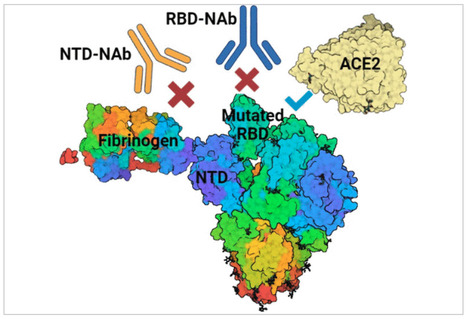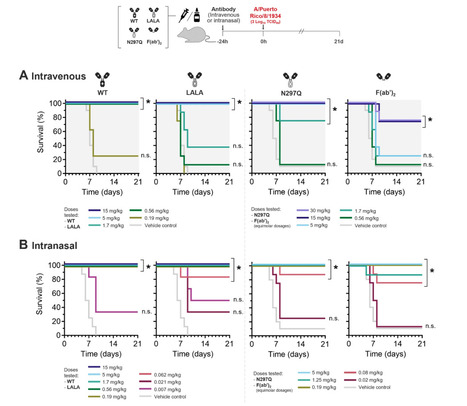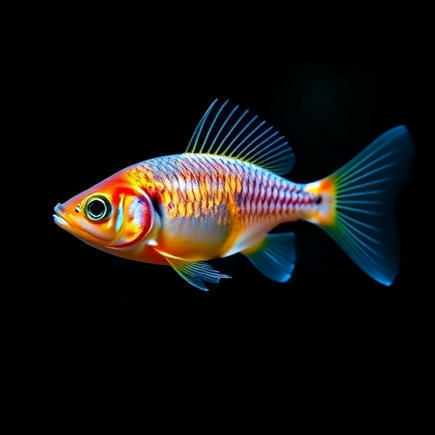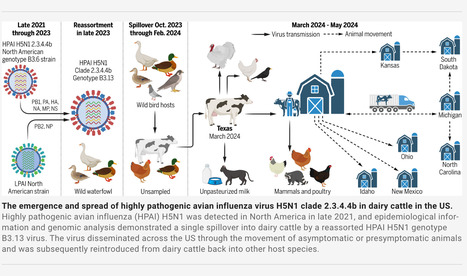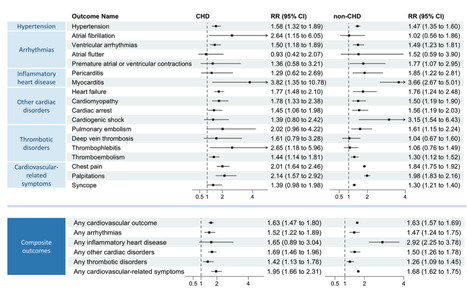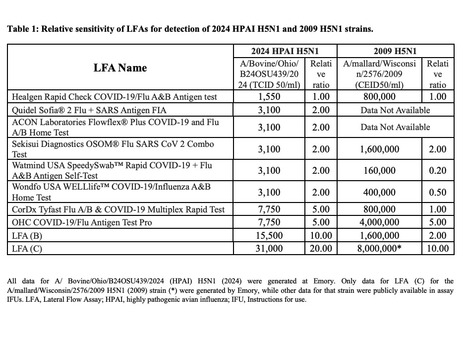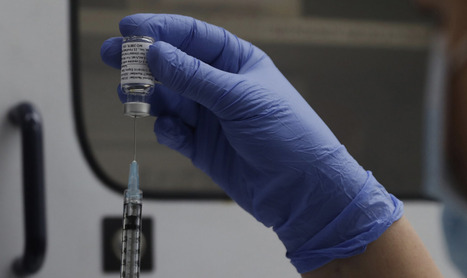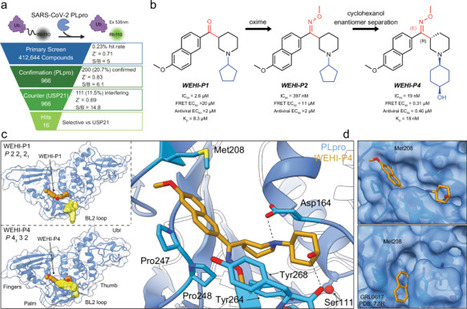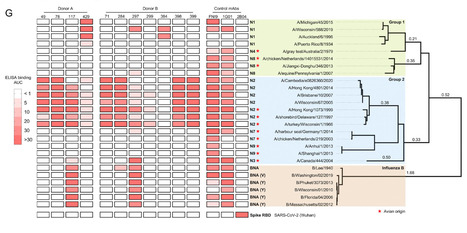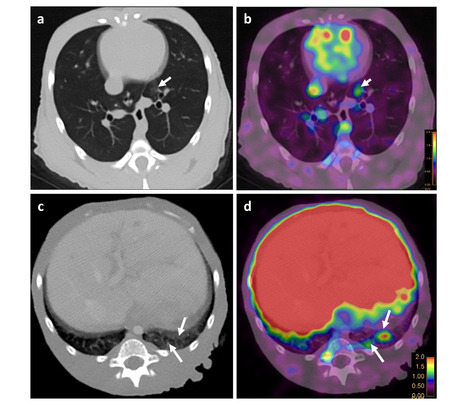 Your new post is loading...

|
Scooped by
Juan Lama
March 17, 2020 8:21 PM
|
RetroVirox offers a menu of cell-based antiviral services to evaluate experimental therapies and vaccines against coronaviruses, including SARS-CoV-2. The company offers in vitro testing with SARS-CoV-2 spike pseudovirions and with live SARS-CoV-2 viruses to evaluate entry inhibitors, neutralizing antibodies, and antivirals against the novel coronavirus causative agent of COVID-19. Multiple viral strains are available for testing, including the most recent Omicron variants of concern (XBB.1.5, XBB.1.16, XBB.2.3.2, EG.5.1, JN.1, KP.2.3, and KP.3). Influenza hemagglutinin (HA) pseudovirus are also available for the evaluation of antibodies and vaccines against H5N1 avian influenza. Pseudoviruses coated with the viral spike (S) protein of SARS-CoV-2 are also used to recapitulate the mode of entry of the novel coronavirus. Over 50 spike mutant and variants are available as pseudoviruses. These assays can be used for the following purposes: - To determine the neutralizing activity of therapeutic antibodies and antisera
- To test experimental COVID-19 vaccines using antisera from inoculated animals or humans
- To evaluate small-molecule and other entry inhibitors targeting the S viral protein, the ACE-2 viral receptor, or host proteases and other targets involved in SARS-CoV-2 viral entry
Assays with live replicating SARS-CoV-2, and milder forms of seasonal human coronaviruses (hCoV-OC43 and 229E) allow for the evaluation of inhibitors at all stages of the coronavirus life cycle. Additional Information about cell-based antiviral assays offered at RetroVirox is available here. Request additional information by email at info@retrovirox.com

|
Scooped by
Juan Lama
May 1, 11:41 AM
|
A research facility within the US National Institutes of Health that is tasked with studying Ebola and other deadly infectious diseases has been instructed by the Trump administration’s Department of Health and Human Services (HHS) to stop research activities. According to an email viewed by WIRED, the Integrated Research Facility in Frederick, Maryland, was told to stop all experimental work by April 29 at 5 pm. The facility is part of the National Institute of Allergy and Infectious Diseases (NIAID) and is located at the US Army base Fort Detrick. It conducts research on the treatment and prevention of infectious diseases that are deemed “high consequence”—those that pose significant risks to public health. It has 168 employees, including federal workers and contractors. The email, sent by Michael Holbrook, associate director for high containment at the Integrated Research Facility, says the lab is terminating studies on Lassa fever, SARS-Cov-2, and Eastern equine encephalitis, or EEE, a rare but lethal mosquito-borne disease that has been reported in several northern US states. “We are collecting as many samples as is reasonable to ensure these studies are of value,” he says in the email. “We have not been asked to euthanize any animals so these animals will continue to be managed.” Holbrook did not respond to an inquiry from WIRED. The email says representatives from the Department of Homeland Security were padlocking freezers in biosafety-level-4 labs, those with the highest level of biosafety containment used for studying highly dangerous microbes. Only about a dozen BSL-4 labs exist in North America. These labs work with the viruses that cause Ebola, Lassa fever, and Marburg, types of hemorrhagic fevers. The Integrated Research Facility is one of only a few places in the world that is able to perform medical imaging on animals infected with BSL-4 agents. “The sacrifice to research is immense,” says Gigi Kwik Gronvall, a senior scholar at the Johns Hopkins Center for Health Security, on the closure. “If things are unused for a period of time, it will cost more money to get them ready to be used again.” The facility’s director, Connie Schmaljohn, has also been placed on administrative leave, according to the email. Previously, Schmaljohn served as a senior research scientist at the US Army Medical Research Institute of Infectious Diseases. She has more than 200 research publications, and her work has led to several clinical trials of first-of-their-kind vaccines. Schmaljohn also did not respond to an inquiry from WIRED. In an emailed statement provided to WIRED, Bradley Moss, communication director for the office of research services at NIH, confirmed the halt in research activity. “NIH has implemented a research pause—referred to as a safety stand-down—at the Integrated Research Facility at Fort Detrick. This decision follows identification and documentation of personnel issues involving contract staff that compromised the facility’s safety culture, prompting this research pause. During the stand-down, no research will be conducted, and access will be limited to essential personnel only, to safeguard the facility and its resources.” Moss did not elaborate on the nature of the personnel issues and said he did not know how long the research pause would last. Staff have not received an anticipated reopening date. The research pause is the latest disruption to federal science agencies after HHS secretary Robert F. Kennedy Jr. announced at the end of March that 10,000 people across the vast federal health agency would lose their jobs, including those at the National Institutes of Health, Food and Drug Administration, and Centers for Disease Control and Prevention. The mass layoffs are part of a restructuring plan being carried out by President Donald Trump’s so-called Department of Government Efficiency.

|
Scooped by
Juan Lama
April 30, 12:53 PM
|
The main protease (MPro) of severe acute respiratory syndrome coronavirus 2 (SARS-CoV-2) is a validated drug target. Starting with a lead-like dihydrouracil chemotype identified in a large-library docking campaign, we improved MPro inhibition >1000-fold by engaging additional MPro subsites and using a latent electrophile to engage Cys145. Advanced leads from this series show pan-coronavirus antiviral activity, low clearance in mice, and for AVI-4773, a rapid reduction in viral titers >1,000,000 after just three doses. Both compounds are well distributed in mouse tissues, including brain, where concentrations >1000× the 90% effective concentration are observed 8 hours after oral dosing for AVI-4773. AVI-4516 shows minimal inhibition of major cytochrome P450s and human proteases. AVI-4516 also exhibits synergy with the RNA-dependent RNA polymerase inhibitor, molnupiravir, in cellular infection models. Related analogs strongly inhibit nirmatrelvir-resistant MPro mutant virus. The properties of this chemotype are differentiated from existing clinical and preclinical MPro inhibitors and will advance therapeutic development against emerging SARS-CoV-2 variants and other coronaviruses. Published in Science Advances (April 23, 2025): https://doi.org/10.1126/sciadv.adt7836

|
Scooped by
Juan Lama
April 29, 11:02 AM
|
A new study seems to confirm that a single dose of the vaccine used to prevent HPV infection is just as effective as two — and, therefore, also helps to prevent cancer. CHICAGO — A clinical trial run by the National Cancer Institute seems to confirm that a single dose of the vaccine used to prevent infection with the human papilloma virus is just as effective as two — and, therefore, also helps to prevent cancer. The result could transform efforts to reach the three-quarters of children globally who should receive the vaccines but don’t. The shots prevent cervical cancer and also anal, penile, and some head-and-neck cancers. Worldwide, 350,000 women die from cervical cancer, the most common HPV cancer. “I think we can all agree that one dose and two doses of … these fantastic vaccines work really well,” said Aimée R. Kreimer, the NCI investigator who presented the new data here Monday at the annual meeting of the American Association for Cancer Research. “We’re really excited about these results.” In developed countries, including the U.S., two doses of the vaccines are currently recommended. But in the clinical trial, whether one dose or two doses were used, the results were equivalent, according to the study of 20,000 girls between ages 12 and 16 in Costa Rica who were followed for 4 1/2 years. In all cases, the estimated efficacy of the vaccines was upwards of 97%.
Experts were fast to praise the results. Chyke A. Doubeni, chief health equity officer The Ohio State University Wexner Medical Center, called them “phenomenal” from the conference stage. He grew up in Nigeria and said he could imagine the findings could help expand access to more people in developing countries. Norman “Ned” Sharpless, who was NCI director in the first Trump administration and is now a managing director at Jupiter Bioventures, echoed those comments. “I think this is the most important cancer prevention trial going on in the world. We have a long history of failure in cancer prevention,” Sharpless said. “To have such clear evidence to support our practice is terrific and this will make the dissemination of HPV vaccine worldwide much easier and much cheaper to do — and it will save millions of lives.” The results could prove controversial not because of science but U.S. politics. Robert F. Kennedy Jr., the secretary of the Department of Health and Human Services, has long criticized HPV vaccines, particularly Gardasil, made by Merck, which is the HPV vaccine used in the U.S. Kennedy has asserted on social media that Gardasil may increase the risk of cervical cancer, a claim contradicted by many studies. During his Senate confirmation hearing, he refused to disavow previous comments he had made questioning the safety of the vaccine.
At Children’s Health Defense, the nonprofit group where he served as founder and chairman for years, Kennedy filed more than two dozen lawsuits over the vaccine. During the nomination process, he promised to give any fees he earned from the Gardasil litigation to his son. But from the start, the development of the HPV vaccines and studies of them could be traced back to the NCI, which is part of HHS. The institute’s deputy director, currently its highest-ranking official, is Douglas Lowy, who was a key figure in the development of the vaccines. He has won multiple scientific prizes, including the National Medal of Technology and Innovation and the Lasker-DeBakey Clinical Medical Research Award, for his work. The NCI has also spent decades studying how to increase the uptake of hepatitis B and HPV vaccines as a way of preventing cancer. In developed countries, the HPV vaccines have had a dramatic impact. In the U.S., Kreimer said, they have decreased the incidence of precancerous cervical lesions by 80% — particularly impressive because only 77% of people in the U.S. who should receive the vaccine have been administered at least one dose. In the U.S. and other developed countries, effective screening against these lesions means that other types of HPV cancer, in particular head-and-neck cancer, are as common as cervical cancer. This is one reason vaccination is recommended for boys as well as girls. Studies across the world have affirmed that HPV vaccination does prevent cancer. In one stunning recent example, Scotland said in 2024 that, of girls in the country who were born between 1988-1996 and had been vaccinated in time, none had been diagnosed with cervical cancer. Australia has said that it believes it can eliminate cervical cancer through vaccination and screening. In the United States, giving two shots of the vaccine has been difficult to achieve on a wide scale among adolescents — a reality that cancer prevention experts have long lamented. In 2019, only 54.2% of adolescents had received two shots of an HPV vaccination. But these new data suggest that the picture is perhaps not as dire as originally feared. In less developed countries, screening for cervical pre-cancers is far less common. These have always been the places where the HPV vaccines could have the biggest impact — but, because the vaccines are costly and because having to give multiple shots of a vaccine makes rolling it out more difficult in these countries — the vaccines have had the least impact there. In her talk, Kreimer said that only 24% of the girls who should get the vaccine worldwide do. That’s why showing that one dose of the vaccines is as effective as two could be so important. And much of this important work has come from the NCI. Rolando Herrero, one of the researchers involved in the new study, was the lead investigator of a study that in 2007 first raised the prospect that fewer doses of an HPV vaccine could be just as effective. That study, the Costa Rica Vaccine Trial, tested three doses of the vaccine Cervarix, which was the dosage used at the time. But 20% of the volunteers in the study received fewer than three doses, in part because there were contraindications to receiving other doses — including becoming pregnant. It appeared that those who received only one dose were protected from HPV just as well as those who were fully vaccinated. “This flew in the face of vaccine dogma,” Kreimer said. At the time, researchers thought protein-based vaccines like Cervarix always needed at least two doses to result in a durable result. But the finding led to other research, including a study in India where a trial stoppage meant that many patients only received one dose of the vaccine. The World Health Organization moved to recommenda one-dose HPV vaccine course. The U.K. also moved to recommend giving just one dose in 2023.
There will not be much debate about using one dose in countries where vaccination has proved difficult. Kathrin Jansen, who led development of Gardasil at Merck and is now retired, noted that in a setting where people are not vaccinated one dose is certainly better than none. “I don’t think there’s going to be any finding in the recent past that’s going to democratize cervical cancer control as much as these studies have,” said CS Pramesh, of the Tata Memorial Centre in Mumbai, from the AACR stage. But there is a question of how quickly the U.S. will consider moving to a single-dose regimen. There are still gaps in the data. For instance, researchers could want more follow-up on vaccine durability. And there are no data on other types of cancers HPV causes, particularly with regard to cancers of the mouth and throat. Still, in recent deliberations, the U.S. Advisory Committee on Immunization Practices has seemed open to a change. On Merck’s recent earnings calls, the company’s chief scientific officer, Dean Li, pushed back against the idea that such a move would come quickly. “I would just emphasize: we have had clear , firm, consistent, and recent guidance from the FDA on what [they] would require for the licensure of a reduced dosing or a single dose. They are very clear on the high evidentiary standard,” Li said, according to a transcript. He added: “The FDA is incredibly up-to-date and aware of the limitations of existing trials, and none meet the criteria for them to have a label change.” Reached for comment, a Merck spokesperson reiterated Li’s statement about the FDA’s high standard. “The FDA is aware of the limitations of ongoing and existing trials, and based on what we know currently, none meet the criteria for approval of a label change to reduced dosing,” the spokesperson said. Kreimer pointed out that the benefit of change could be measured in lives saved.
“Cervical cancer is a horrible disease, and outside the U.S., in lower-income countries, it is a death sentence the incidence is the mortality,” she said. Better then, to keep the cancer from ever happening in the first place.

|
Scooped by
Juan Lama
April 24, 12:21 PM
|
Recent studies have implied an increased incidence of autoimmune diseases following the SARS-CoV-2 pandemic. The objective was to determine if SARS-CoV-2 infections were associated with celiac disease (CD), type 1 diabetes (T1D), and autoimmune thyroid disease (AITD) autoantibodies in a population-based screening when the pandemic hit the South of Sweden during 2021 and 2022. Between August 2021 and June 2022 self-obtained capillary plasma samples were collected from 1088 children at 6–9 years of age and 1185 adolescents at 13–16 years of age, who were randomly invited from the general population to a screening for CD, T1D, AITD, and SARS-CoV-2 antibodies. Among children and adolescents screened for autoantibodies associated with CD, T1D and AITD, the SARS-CoV-2 infection rate was increased in tissue transglutaminase autoantibody (tTGA) positive (13/17; 76.5%) compared with tTGA negative (492/1168; 42.1%) 13–16-year-old individuals (p = 0.0057). There was no association between SARS-CoV-2 infection rate and AITD- or T1D autoantibodies. Our findings indicate a potential association between prior SARS-CoV-2 infection and screening-detected CD autoimmunity in adolescents aged 13–16 years. Further research is needed to elucidate whether ongoing CD autoimmunity increases susceptibility to infection or if SARS-CoV-2 may act as a trigger for CD autoimmunity in genetically and environmentally predisposed individuals. Published (April 15, 2025): https://doi.org/10.1080/08916934.2025.2490491

|
Scooped by
Juan Lama
April 23, 12:19 PM
|
WASHINGTON, April 21 (Reuters) - The Food and Drug Administration is suspending a quality control program for testing of fluid milk and other dairy products due to reduced capacity in its food safety and nutrition division, according to an internal email seen by Reuters. The suspension is another disruption to the nation's food safety programs after the termination and departure of 20,000 employees of the Department of Health and Human Services, which includes the FDA, as part of President Donald Trump's effort to shrink the federal workforce. The FDA this month also suspended existing and developing programs that ensured accurate testing for bird flu in milk and cheese and pathogens like the parasite Cyclospora in other food products. Effective Monday, the agency suspended its proficiency testing program for Grade "A" raw milk and finished products, according to the email sent in the morning from the FDA's Division of Dairy Safety and addressed to "Network Laboratories." Grade "A" milk, or fluid milk, meets the highest sanitary standards. The testing program was suspended because FDA's Moffett Center Proficiency Testing Laboratory, part of its division overseeing food safety, "is no longer able to provide laboratory support for proficiency testing and data analysis," the email said. An HHS spokesperson said the laboratory was already set to be decommissioned before the staff cuts and though proficiency testing would be paused during the transition to a new laboratory, dairy product testing will continue. The Trump administration has proposed cutting $40 billion from the agency. The FDA's proficiency testing programs ensure consistency and accuracy across the nation's network of food safety laboratories. Laboratories also rely on those quality control tests to meet standards for accreditation. "The FDA is actively evaluating alternative approaches for the upcoming fiscal year and will keep all participating laboratories informed as new information becomes available," the email said.

|
Scooped by
Juan Lama
April 18, 10:54 AM
|
Researchers evaluated the safety and immune response of a poultry-derived H5N1 avian influenza vaccine in black vultures and critically endangered California condors. The findings support the use of vaccination as a conservation tool against deadly avian flu outbreaks. A team of US-based researchers recently tested the safety and efficacy of a licensed avian influenza vaccine in protecting California condors, a critically endangered bird species, against the highly pathogenic avian influenza virus. They published the study findings in Emerging Infectious Diseases, an official Centers for Disease Control and Prevention (CDC) journal. Background Since 2020, the highly pathogenic avian influenza (HPAI) virus, specifically influenza A(H5N1) clade 2.3.4.4b, has caused a panzootic (similar to a pandemic in humans) in poultry and wild birds and a subsequent spillover into wild mammals. Birds can readily contract avian influenza virus infection with or without exhibiting clinical symptoms and shed large amounts of virus, leading to widespread dispersion. Wild birds infected with the H5N1 HPAI virus were first detected in the United States in January 2022. The California condor is the highest-profile wildlife species known to be affected by the HPAI virus in North America. The California condor is a critically endangered species. Exposure to lead, a heavy metal and immunosuppressant, is considered the most critical factor limiting the growth and recovery of condor populations. Many field-based and captive conservation efforts have been initiated since the 1970s to save these largest land birds in North America. However, an HPAI outbreak among these birds in 2023 has caused more than 21 deaths in the United States. The 2023 outbreak killed approximately 18% of the northern Arizona and southern Utah condor subpopulation, while other subpopulations were not affected. In some countries where the avian influenza virus is endemic in poultry, vaccines against HPAI viruses have been evaluated to reduce illness, death, and viral transmission. However, these vaccines have never been tested in California condors despite evidence of a vaccine-related protective immune response in other captive species, including raptors. Due to the high conservation value and risk associated with working directly with condors, the current study first tested the vaccine in black vultures as a surrogate species before proceeding with the condors themselves. About the Study In the current study, researchers investigated the safety and efficacy profiles of a conditionally licensed influenza subtype H5N1 poultry vaccine, initially in black vultures and subsequently in California condors. They selected black vultures as a surrogate species for California condors to initially ascertain the vaccine's safety and efficacy in these abundant and easily available species. The vaccine used in the study was developed by Zoetis, Inc., which also donated the vaccine and provided expertise for the trial. The researchers randomly assigned 28 black vultures into three groups. The first group received two doses (0.5 milliliters each) of the vaccine given at an interval of 21 days; the second group received a single vaccine dose (1.0 milliliters); and the third group remained unvaccinated. For the California condor trial, a similar design was used, but with modifications to reduce risk and stress: condors were located at multiple facilities, vaccinations were staged to confirm safety before proceeding, and blood samples were collected less frequently (at 0, 21, and 42 days post-vaccination) to minimize handling of these endangered birds. Study Findings The study found that both black vultures and California condors produced significantly higher levels of antibodies in response to the vaccine than unvaccinated birds. However, the short-term antibody response was stronger in black vultures than in California condors. Specifically, 95% of vaccinated vultures and 80% of vaccinated condors showed a measurable antibody response within the published protective range. Regarding vaccination regimen, the study found that birds receiving a single vaccine dose generated a weaker antibody response that dissipated more rapidly. This finding suggests that a prime-boost (two-dose) vaccination regimen would be more effective in protecting birds against infections caused by HPAI viruses. However, the difference in antibody response between the two regimens was not statistically significant, although qualitative trends favored the two-dose approach. The study was unable to evaluate long-term differences in waning immunity between the two vaccination regimens, as the antibody response was determined only 42 days after vaccination. The study was unable to detect a significant impact of either sex or bone lead concentration on the antibody response, which may be due to the small sample size and uneven sex ratio of the sample group. The researchers believe that in the absence of these two limitations, they might have detected significant impacts of these two correlates of antibody response. Nevertheless, they noted that birds with the strongest antibody response were also those with the lowest bone lead level, regardless of vaccine regimen. The authors caution that these findings are tentative and that a larger, more balanced sample might reveal the real effects of sex or lead exposure. Regarding safety, the study found that none of the vaccinated birds (both vultures and California condors) exhibited significant adverse reactions. No changes in behavioral or physical activity were observed in birds following vaccination. The only minor adverse effect observed was the development of small, temporary nodules at the injection site in two vultures, which resolved without intervention. Study Significance The study highlights the importance of vaccinating threatened and endangered bird species against highly virulent and currently circulating HPAI viruses to protect them from deadly infections. Overall, the findings suggest that licensed vaccines can be a realistic strategy to aid in conserving condors and potentially other species facing similar threats, especially those with small and highly threatened populations. Vaccination may be particularly relevant when a population's resiliency has decreased to the extent that naturally occurring illness and death from disease could impair the species’ long-term persistence. The authors note that, despite species-specific differences in vaccine response, evidence from the literature suggests that even vaccination strategies covering less than 50% of an affected wildlife population can be effective at preventing extinction. They also emphasize the need for ongoing monitoring of vaccine effectiveness in the field, as well as demographic modeling to optimize vaccination strategies for wild populations, taking into account factors such as timing, age class, and proportion vaccinated. Given the economic benefits associated with poultry farming, researchers emphasize the need for close coordination with the US Department of Agriculture (USDA) and numerous other federal and state agencies to obtain authorization for implementing these vaccination trials. Given the significant threat from HPAI viruses, the US Fish and Wildlife Service (USFWS) decided to initiate a California Condor Recovery Program vaccination program. By October 2024, 207 condors had received at least one vaccination. The authors stress that this vaccination effort is unique within the United States and represents an unprecedented coordinated response to an emerging disease threat facing an endangered species. REsearch published in Emerging Inf. Dis. (June 2025): https://wwwnc.cdc.gov/eid/article/31/6/24-1558_article

|
Scooped by
Juan Lama
April 17, 12:49 PM
|
Today, antiviral medications can turn HIV, a once fatal infection, into a chronic condition. Nonetheless, the cocktail of pills remains out of reach for many—and lapses in the daily regimen make them less effective. Wesley Sundquist, a biochemist at University of Utah, and Tomas Cihlar, a virologist at Gilead, a biopharmaceutical company, have labored for more than a dozen years to turn one antiviral treatment, lenacapavir, into a twice-a-year therapy to prevent HIV infection in those at high risk. Sundquist laid the groundwork in studying one of HIV’s proteins, the capsid, which creates a protective shell around the virus’ genome; Cihlar visited his labs and was impressed enough to take his discoveries to Gilead. There, his team found ways to extend the effect of the drug over six months, meaning infected patients only receive two injections a year to treat HIV. Researchers are now studying lenacapavir in people who are not HIV positive but are at high risk of exposure. If approved, it would be the first twice-a-year injected drug to prevent HIV. Early results show great promise.

|
Scooped by
Juan Lama
April 10, 11:20 AM
|
Learn why lowering the viral load in the mouth could be a game-changer in fighting viruses like herpes, bird flu, and more. Beyond the heavy hitters like COVID-19, bird flu, and Ebola, more common viral infections — such as the annual flu — cost the U.S. an estimated $11.2 billion each year in lost productivity alone, leaving a huge burden on our health system and the economy. Another widespread virus that transmits through oral contact is herpes simplex virus-1 (HSV-1), which infects over two-thirds of the global population and can, in rare cases, lead to encephalitis or infectious blindness. Vaccines remain a cornerstone of prevention, but low vaccination rates, waning immunity in older adults, or the absence of available vaccines — as is the case with HSV — highlight the need for new strategies to reduce disease spread. Researchers from the University of Pennsylvania’s School of Dental Medicine, in collaboration with a Finnish team, have explored an unusual but promising solution: chewing gum infused with antiviral compounds. Their study published in Molecular Therapy shows that this gum can significantly reduce the viral load in the mouth using compounds naturally found in beans. Chewing Gum vs. COVID-19 Instead of focusing solely on preventing infection, the researchers looked at targeting viral transmission by lowering the number of viruses present in the mouth. While vaccines are excellent at preventing severe illness, they don’t always reduce the chances of spreading the virus — and they come with challenges like distribution, cost, storage, and the need for injection. That’s where chewing gum comes in. It’s easy, non-invasive, and directly targets the area where many viruses first replicate and spread. In one of their earlier studies, the Penn team added an antiviral protein called CTB-ACE2 to gum, which neutralized over 95 percent of SARS-CoV-2 particles in the saliva of COVID-19 patients, including major variants like beta, delta, and omicron. These encouraging results have already moved into clinical trials. Expanding the to Tackle Flu and Herpes Building on this success, Henry Daniell, a professor at Penn School of Dental Medicine, and his team incorporated a different antiviral protein — Flt3 Receptor Interacting Lectin (FRIL), derived from lablab beans — into gum and tested its effectiveness on multiple strains of influenza and HSV. Using a mastication simulator (a mechanical chewing device), they showed that over half of the active compound was released within 15 minutes. Just 40 milligrams of FRIL was enough to reduce more than 95 percent of the viral load present. The gum already meets FDA safety standards and is easy to store, making it a convenient product that could hit the market relatively soon. Fighting the Spread of Bird Flu According to a recent press release, FRIL also appears effective against two strains of bird flu. While chewing gum might not be an option for birds, the researchers are now testing lablab bean powder as an additive in bird feed. “Controlling transmission of viruses continues to be a major global challenge,” said Daniell in the release. “A broad-spectrum antiviral protein (FRIL), present in a natural food product (bean powder), that neutralizes not only human flu viruses but also avian flu is a timely innovation to prevent their infection and transmission.” Research Published in Molecular Therapy (Jan. 8, 2025): https://doi.org/10.1016/j.ymthe.2024.12.008

|
Scooped by
Juan Lama
April 9, 10:32 AM
|
Background The purpose of this study was to evaluate the effectiveness of the influenza vaccine during the 2024-2025 respiratory viral season. Methods Employees of Cleveland Clinic in employment in Ohio on October 1, 2024, were included. The cumulative incidence of influenza among those in the vaccinated and unvaccinated states was compared over the following 25 weeks. Protection provided by vaccination (analyzed as a time-dependent covariate) was evaluated using Cox proportional hazards regression. Results Among 53402 employees, 43857 (82.1%) had received the influenza vaccine by the end of the study. Influenza occurred in 1079 (2.02%) during the study. The cumulative incidence of influenza was similar for the vaccinated and unvaccinated states early, but over the course of the study the cumulative incidence of influenza increased more rapidly among the vaccinated than the unvaccinated. In an analysis adjusted for age, sex, clinical nursing job, and employment location, the risk of influenza was significantly higher for the vaccinated compared to the unvaccinated state (HR, 1.27; 95% C.I., 1.07 – 1.51; P = 0.007), yielding a calculated vaccine effectiveness of −26.9% (95% C.I., −55.0 to −6.6%). Conclusions This study found that influenza vaccination of working-aged adults was associated with a higher risk of influenza during the 2024-2025 respiratory viral season, suggesting that the vaccine has not been effective in preventing influenza this season. Summary Among 53402 working-aged Cleveland Clinic employees, we were unable to find that the influenza vaccine has been effective in preventing infection during the 2024-2025 respiratory viral season. Preprint in medRxiv (April 4, 2025): https://doi.org/10.1101/2025.01.30.25321421

|
Scooped by
Juan Lama
April 7, 11:35 AM
|
The highly pathogenic avian influenza (HPAI) H5N1 virus has been endemic in aquatic birds since 1997, causing outbreaks in domestic poultry and occasional human infections worldwide. Recently, the cross-species transmission of a new reassortant variant from clade 2.3.4.4b of H5N1 to cattle in the US has heightened concerns regarding the expansion of host range and potential human infection. As eradicating the H5N1 virus from its reservoir is impossible, it is essential to prepare for a potential pandemic caused by an H5N1 derivative. Utilizing a deleted-NS1 live attenuated influenza viral vector vaccine system (DelNS1 LAIV), a system we have previously used in the development of a COVID-19 vaccine, we have rapidly developed an intranasal vaccine for cattle H5N1 and related clade 2.3.4.4b strains, based on publicly available sequences. Our research demonstrates that a single intranasal immunization can provide effective protection against lethal challenges from HPAI cattle or mink H5N1 variants, offering strong, sustained immunity after two months in female mouse and male hamster models. Immunogenicity analysis reveals that intranasal vaccination with DelNS1 LAIV induces robust neutralizing antibody, mucosal IgA and T cell responses in mice. It is crucial to further evaluate the DelNS1-H5N1 LAIV system to prepare for potential future H5N1 outbreaks in humans. Current seasonal flu vaccines hardly protect against emerging H5N1 such as clade 2.3.4.4b circulating in cattle. Here, the authors show that a single intranasal immunization of DelNS1-H5N1 vaccine candidates provides effective protection and sustained immunity against highly pathogenic avian influenza A viruses. Published in Nature Comm. (April 1, 2025): https://doi.org/10.1038/s41467-025-58504-z

|
Scooped by
Juan Lama
April 5, 10:58 AM
|
MEXICO CITY, April 4 (Reuters) - Mexico has detected its first human case of H5N1 avian influenza, also known as bird flu, the health ministry said on Friday. The infection was confirmed on Tuesday in a three-year-old girl living in the northern state of Durango, who remains hospitalized in serious condition. "So far there is no evidence of sustained person-to-person transmission," the health ministry said in a statement, adding that the World Health Organization (WHO) considers the public health risks of the virus to the general population to be low. A particularly severe variant of the H5N1 strain has been spreading around the world in animals since 2020, causing lethal outbreaks in commercial poultry and sporadic infections in other species from alpacas to house cats. Last year, it was detected in cows for the first time. Durango's economy is heavily reliant on agriculture, primarily its cattle industry. Last year, the WHO reported Mexico's first laboratory-confirmed human case of infection with the A(H5N2) bird flu in a person who had no known exposure to animals and later died of chronic illness.

|
Scooped by
Juan Lama
April 1, 1:09 PM
|
The host protein fibrinogen has been found to interact with the N-terminal domain (NTD) of the spike protein in SARS-CoV-2. However, the evolutionary benefit of this binding to the virus still remains unclear. Herein, we put forward with rationale and supporting evidence that the binding of fibrinogen to its more conserved NTD is an immune evasion strategy adopted by the virus to outsmart the NTD targeted neutralizing antibodies. Published in ACS Pharmacology & Translational Science (March 19, 2025): https://doi.org/10.1021/acsptsci.5c00122
|

|
Scooped by
Juan Lama
Today, 10:41 AM
|
Monoclonal antibodies have two core mechanisms of protection: an antibody’s antigen-binding fragment (Fab) can bind and neutralize viral pathogens and its fragment crystallizable domain (Fc) catalyzes effector functions. We investigated the relative contribution of Fab- versus Fc-mediated mechanisms of protection through passive administration of distinct forms of the pan-reactive anti-influenza antibody CR9114. We demonstrated that the contribution of Fc-independent (Fab-dependent) versus Fc-dependent mechanisms of protection is defined by the route of administration. We used CR9114 variants (wild-type, two Fc-silenced variants, or the bivalent antigen-binding fragment F(ab′)2), administered either intravenously or intranasally. We found that intravenously-administered CR9114 requires the Fc domain to provide potent, pre-exposure protection against influenza A and B viral challenge. In contrast, when CR9114 was administered locally to the nasal mucosa, the main mode of protection was provided by F(ab′)2, and was largely Fc-independent. Importantly, this mode of protection following intranasal administration also applied to non-neutralized influenza B strains. Moreover, intranasal administration resulted in an increase in potency against influenza A/H1N1, A/H5N1, A/H3N2, B/Yam and B/Vic compared to intravenous administration up to 50-fold. These results shed new light on the application of monoclonal antibodies such as CR9114 to combat viral infection locally, and will help inform clinical strategies of pre-exposure prophylaxis. More fundamentally, this study uncovers distinct modes of protection for systemic versus intranasally-administered prophylactic antibodies. Published in Scientific Reports (April 8, 2025): https://doi.org/10.1038/s41598-025-94314-5

|
Scooped by
Juan Lama
May 1, 11:26 AM
|
In a groundbreaking study set to redefine our understanding of microbial ecosystems, researchers have unveiled a fierce yet invisible battleground occurring within the gut of zebrafish—a widely accepted model organism. The study, led by Ortiz de Ora, Wiles, Zünd, and colleagues, introduces “Phollow,” an advanced imaging and analytical platform capable of visualizing bacteriophage transmission dynamics at the astonishing resolution of single virions. Published in Nature Microbiology in 2025, this research offers unprecedented insights into the viral undercurrents shaping microbiomes in vivo, a feat long sought but rarely achieved at this microscopic scale. The gut microbiome, a complex and dynamic consortium of bacteria, viruses, and other microorganisms, has been intensively studied for its critical role in health and disease. However, viruses that infect bacteria—bacteriophages—have remained enigmatic players due to the difficulties in tracking their interactions within complex environments. Phollow’s innovation lies in overcoming these challenges; it visualizes individual phages and their transmission from one bacterial host to another in the living intestine of the zebrafish, marking the first time that in situ phage dynamics have been resolved with this level of detail. At the heart of this technology is a multi-modal fluorescence microscopy system integrated with advanced computational algorithms. Each virion’s position, identity, and temporal movement are mapped in real-time, allowing researchers to observe the infection cycles of diverse phage populations. Through this lens, the team uncovered that phage transmission is not a random spray but a carefully orchestrated, spatially and temporally regulated process. Phages appear to use microenvironmental cues within the intestinal milieu to optimize the infection of their bacterial hosts, influencing community composition and function dynamically. Moreover, Phollow’s ability to track phage propagation through the gut microbiome revealed distinct transmission patterns that challenge the classical notion of phages as passive agents. Instead, phages actively navigate the mucosal surfaces, “hunting” for particularly susceptible bacterial strains. The dynamics demonstrated by the researchers emphasize a level of viral strategy akin to a microscopic arms race — a viral chess game played at the molecular level within our gut ecosystem. This revelation gains significance considering the impact of microbiomes on animal and human health. Microbial communities regulate essential physiological processes such as nutrient absorption, immune development, and pathogen resistance. By elucidating the intimate viral-bacterial interactions, Phollow sets the stage for novel therapeutic interventions that could harness or modulate phage activity to reshape microbiome composition for better health outcomes or disease mitigation. The methodology itself is a tour de force. Phollow couples bespoke fluorescent tagging of phages and bacterial hosts with microfluidic gut simulators and live animal imaging technology. This interconnected system allows observation of natural behaviors without disrupting the ecosystem’s integrity, a critical advancement over previous in vitro studies where environmental context was lost. The computational pipeline sifts through massive imaging datasets to reconstruct the spatiotemporal paths of thousands of virions, delivering quantitative data on transmission frequencies, host specificity, and lysis efficiency. One of the more surprising findings detailed in the paper is the heterogeneity of phage infection cycles within the microbiome. While classical microbiology assumes uniform infection dynamics, Phollow highlighted that virions differ significantly in their infection success rates, depending on local bacterial density, motility, and even metabolic state. These factors create complex “micro-niches” where some phages thrive while others fade, fostering a constantly shifting viral landscape that shapes bacterial population genetics and ecology. Importantly, the zebrafish model proved essential for these advances—not just due to its optical transparency at larval stages but also because of its well-characterized gut microbiome, which allows for the introduction of defined bacterial and phage strains. This system offers a versatile platform to translate findings into mammalian contexts, helping to decode how viral-bacterial interactions may operate in human gut ecosystems—a frontier of medical microbiology that remains relatively unexplored. The study also touches upon the evolutionary implications of the observed phage dynamics. The cooperative behaviors and competitive interactions among phages, as revealed by single-virion tracking, suggest a sophisticated level of viral social interaction. These interactions influence horizontal gene transfer, bacterial immune evasion, and phage-mediated control of bacterial diversity, playing a pivotal role in microbial evolution and adaptation that shapes host health over time. Further, the Phollow platform is poised to revolutionize the field of viromics by enabling direct observation of phage-bacteria interactions in varied environmental contexts beyond the gut. Whether studying soil microbial consortia, marine ecosystems, or industrial bioreactors, this technology offers an adaptable tool to unlock viral ecology’s complex mechanisms, moving beyond indirect inference to direct visualization—a paradigm shift for microbial ecology. The implications for human medicine are profound. As antibiotic resistance escalates globally, phage therapy reemerges as a promising alternative to fight bacterial infections. Understanding phage transmission dynamics in situ provides the necessary foundation for designing phage cocktails that deliver maximum efficacy while minimizing unintended disruption of the microbiome. Insights gained using Phollow might inform precision phage therapies tailored to individual microbiomes, marking a new era in personalized medicine. Additionally, the study opens avenues to explore host immune modulation by phages during infection. As phages interact intimately with bacterial hosts, their presence indirectly or directly influences immune signaling pathways. The ability to observe these dynamics at high spatiotemporal resolution enables better understanding of phage roles beyond bacterial predation, including potential involvement in training host immune responses or maintaining mucosal homeostasis. The research also addresses challenges intrinsic to phage research, such as the extreme diversity and rapid evolution of viral populations. Employing high-throughput, high-resolution visualization paired with machine learning enables researchers to parse highly heterogeneous viral populations, discriminate between closely related strains, and monitor real-time evolutionary dynamics. This approach heralds a new era where complexity no longer obstructs detailed mechanistic insights but rather enriches our understanding. In sum, the advent of Phollow represents a monumental leap in virology and microbiome research, bringing clarity to the hidden viral interactions that govern microbial ecosystems. Ortiz de Ora and colleagues have not only unveiled a method of unparalleled resolution and sophistication but also sketched a new conceptual framework positioning phages as active architects of microbial community dynamics. The broader scientific community and clinical research stand to benefit immensely from these findings, which blur boundaries between microbiology, ecology, immunology, and evolutionary biology. As interest in microbiome manipulation heightens, the capability to visualize and decode phage transmission inside living hosts is a pivotal tool empowering researchers to harness these tiny yet potent biological agents. Looking forward, Phollow and its underlying principles are expected to catalyze a wave of discoveries that will transform microbiome science, from fundamental research to translational applications that improve health and disease resilience across species. This seminal work signals a shift in how we perceive the invisible viral world—moving from static snapshots to live-action views, where every virion writes a part of the microbiome’s intricate story. Phollow shines a light on this previously uncharted viral frontier, setting a new standard for how profoundly we can understand and eventually harness the power of phages within living systems. Research published in Nat Microbiol (April 18, 2025). :

|
Scooped by
Juan Lama
April 30, 12:18 PM
|
New initiative aims to reduce use of animals in NIH-funded research. The National Institutes of Health (NIH) is adopting a new initiative to expand innovative, human-based science while reducing animal use in research. Developing and using cutting-edge alternative nonanimal research models aligns with the U.S. Food and Drug Administration’s (FDA) recent initiative(link is external) to reduce testing in animals. While traditional animal models continue to be vital to advancing scientific knowledge, using new and emerging technologies can offer unique strengths that, when utilized correctly or in combination, can expand the toolbox for researchers to answer previously difficult or unanswerable biomedical research questions. “For decades, our biomedical research system has relied heavily on animal models. With this initiative, NIH is ushering in a new era of innovation,” said NIH Director Dr. Jay Bhattacharya. “By integrating advances in data science and technology with our growing understanding of human biology, we can fundamentally reimagine the way research is conducted—from clinical development to real-world application. This human-based approach will accelerate innovation, improve healthcare outcomes, and deliver life-changing treatments. It marks a critical leap forward for science, public trust, and patient care.” Some bodies of research have been inconclusive on the efficacy of translating the results of animal models to human diseases, such as Alzheimer’s disease and cancer. These translational challenges to humans may be due to differences in anatomy, physiology, lifespan, and disease characteristics. While humans and animals may share genes, some studies have shown there could be functional differences between organ and body systems that may result in some translational limitations. New and emerging technologies have begun to allow researchers to study health and disease using human information, making them an alternative avenue to yield replicable, translatable, and efficient results either alone or in combination with animal models. These technologies include: - Organoids, tissue chips, and other in vitro systems that allow scientists to model human disease and capture human variability and patient-specific characteristics.
- Computational models which simulate complex biological human systems, disease pathways, and drug interactions.
- Real-world data that allow scientists to study health outcomes in humans at community and population levels.
To integrate innovative human-based science, the NIH intends to establish the Office of Research Innovation, Validation, and Application (ORIVA) within NIH’s Office of the Director. The new office will coordinate NIH-wide efforts to develop, validate, and scale the use of non-animal approaches across the agency’s biomedical research portfolio and serve as a hub for interagency coordination and regulatory translation for public health protection. ORIVA will expand funding and training in non-animal approaches and awareness of their value in translational success. New funding opportunities will include evaluation criteria that assess methods based on their suitability for the research question, context of use, translatability, and human relevance. Infrastructure for non-animal approaches will also be expanded to make these methods more accessible to researchers. In addition, grant review staff will participate in mitigation training to address any possible bias towards animal studies and integrate experts on alternative methods into study sections. NIH will also publicly report on research spending annually to measure progress toward reduction of funding for animal studies and an increase in funding for human-based approaches. About the National Institutes of Health (NIH): NIH, the nation's medical research agency, includes 27 Institutes and Centers and is a component of the U.S. Department of Health and Human Services. NIH is the primary federal agency conducting and supporting basic, clinical, and translational medical research, and is investigating the causes, treatments, and cures for both common and rare diseases. For more information about NIH and its programs, visit www.nih.gov.

|
Scooped by
Juan Lama
April 28, 6:37 PM
|
INTRODUCTION Highly pathogenic avian influenza (HPAI) viruses have critical consequences for animal health and the agricultural economy—and may have pandemic potential. HPAI related to the goose/Guangdong 2.3.4.4 hemagglutinin (HA) H5NX phylogenetic clade has spread to nearly 100 countries, and it is recognized as a panzootic. HPAI virus circulation is ongoing in North America, and after a trans-Atlantic incursion in late 2021, the HPAI H5N1 clade 2.3.4.4b virus caused widespread outbreaks. The outbreaks resulted in extensive mortality events, culling of poultry when detected in agricultural systems, and interspecies transmission events into mammals. It is critical to determine how HPAI clade 2.3.4.4b evolves in wild birds and in nonhuman mammals after spillover to assess the potential for human infection and transmission. RATIONALE In late January 2024, veterinarians observed dairy cattle displaying decreased feed intake and changes in milk quality and production. On 25 March 2024, HPAI H5N1 clade 2.3.4.4b was confirmed in dairy cattle in Texas. Shortly thereafter, the virus was identified in cattle in eight other United States (US) states by members of the National Animal Health Laboratory Network. The goal of this study was to analyze genetic sequence data collected after the introduction of HPAI H5N1 in late 2021 into the Atlantic flyway of North America and its onward circulation and reassortment with North American wild bird–origin low-pathogenicity viruses. These data were combined with whole-genome sequence data and epidemiological information from the HPAI H5N1 outbreak among US dairy cattle to help us understand when the interspecies transmission event to cattle occurred and the consequences of animal movement for virus spread. RESULTS H5N1 clade 2.3.4.4b genotype B3.13 influenza A virus was confirmed in milk with limited detections in nasal swabs. The initial outbreak included samples from 26 dairy cattle premises across eight states and six poultry premises in three states. The sequences isolated from cattle clustered within a single group in phylogenetic analyses, supporting a single spillover event in late 2023. A reassortment event preceded the spillover, and after introduction, the virus persisted in cattle with evidence for transmission from cattle into poultry and peridomestic animal species. Epidemiological records and phylodynamic modeling documented that the movement of asymptomatic or presymptomatic dairy cattle resulted in the dissemination of the virus across the US. We identified low-frequency within-host sequence variants across the genome that were associated with changes in virulence, host-range specificity, and mammalian adaptation. CONCLUSION A single wild bird-to-cattle transmission event of HPAI H5N1 clade 2.3.4.4b occurred in late 2023. The spillover was likely preceded by a reassortment event in wild bird populations followed by the movement of cattle that spread HPAI within the US dairy herd. Molecular markers that may lead to changes in transmission efficiency and phenotype were detected at low frequencies. Continued transmission of H5N1 HPAI within dairy cattle increases the risk for infection and subsequent spread of the virus to humans and other host populations. Published in Science (April 25, 2025): https://www.science.org/doi/10.1126/science.adq0900

|
Scooped by
Juan Lama
April 23, 12:39 PM
|
The risk of cardiovascular outcomes following SARS-CoV-2 infection has been reported in adults, but evidence in children and adolescents is limited. This paper assessed the risk of a multitude of cardiac signs, symptoms, and conditions 28-179 days after infection, with outcomes stratified by the presence of congenital heart defects (CHDs), using electronic health records (EHR) data from 19 children’s hospitals and health institutions from the United States within the RECOVER consortium between March 2020 and September 2023. The cohort included 297,920 SARS-CoV-2-positive individuals and 915,402 SARS-CoV-2-negative controls. Every individual had at least a six-month follow-up after cohort entry. Here we show that children and adolescents with prior SARS-CoV-2 infection are at a statistically significant increased risk of various cardiovascular outcomes, including hypertension, ventricular arrhythmias, myocarditis, heart failure, cardiomyopathy, cardiac arrest, thromboembolism, chest pain, and palpitations, compared to uninfected controls. These findings were consistent among patients with and without CHDs. Awareness of the heightened risk of cardiovascular disorders after SARS-CoV-2 infection can lead to timely referrals, diagnostic evaluations, and management to mitigate long-term cardiovascular complications in children and adolescents. Post-acute sequelae of SARS-CoV-2 infection affecting the cardiovascular system have been reported, but evidence in young people is limited. Here, the authors quantify the incidence of a range of outcomes in children and adolescents using electronic health records from the United States. Published in Nature Comm. ( April 11, 2025): https://doi.org/10.1038/s41467-025-56284-0

|
Scooped by
Juan Lama
April 22, 12:17 PM
|
Background Highly pathogenic avian influenza (HPAI) A(H5N1) clade 2.3.4.4b was first detected in birds in the United States in 2021 and an ongoing outbreak in dairy cattle began in early 2024. At least 70 U.S. cases have been identified in humans with exposure to infected cattle, poultry, and wild birds. No human-to-human transmission has been documented. However, as part of diagnostic preparedness, we evaluated the ability of currently available influenza tests to detect 2024 U.S. H5N1 strains. Methods Contrived nasal swab samples were prepared using live or inactivated 2024 H5N1 and used to test twelve rapid antigen tests (lateral flow assays, or LFA), including 10 commercially-available influenza A LFAs and two H5-specific LFAs. Five point-of-care (POC) molecular assays were also tested. An inclusivity testing protocol was used, wherein a predetermined dilution series is used to evaluate each assay, enabling head-to-head comparison of assay performance. Results All lateral flow assays and POC molecular tests were able to detect bovine 2024 H5N1 (genotype B3.13). Sensitivity for the POC molecular tests (heat-inactivated virus) ranged from 1.55 to 7.75 TCID50/swab. For 11/12 LFAs, including 10 commercial influenza A tests and an RUO H5 assay, sensitivity (live virus) ranged from 78-1550 TCID50/swab. Testing of four LFAs confirmed inclusivity for a genotype D1.1 strain. Conclusions Available rapid antigen and point-of-care molecular influenza tests can detect 2024 U.S. H5N1 strains in contrived samples, with a wide range of analytical sensitivity. In the event of human-to-human transmission, clinical performance and optimal sample types would need to be established. Summary Recent human infections with H5N1 influenza necessitate diagnostic preparedness. Reassuringly, commercially available rapid antigen and point-of-care molecular influenza tests detected the 2024 U.S. bovine H5N1 strain in contrived specimens. Clinical performance should be evaluated if human-to-human transmission is observed. Preprint in medRxiv (April 16, 2025): https://doi.org/10.1101/2025.04.15.25325613

|
Scooped by
Juan Lama
April 17, 1:03 PM
|
Infection of highly pathogenic avian influenza (HPAI) H5N1 clade 2.3.4.4b in dairy cows causes severe mastitis and milk production losses. Whether cows can develop protective immunity is unclear. Here we infected three lactating cows with HPAI H5N1 genotype B3.13 via the hindquarters of the udder to mimic intra-mammary infection. Inoculated cows displayed clinical responses consistent with affected dairy herds in the United States including virus shedding almost exclusively in inoculated hindquarters that peaked between Days 2–4 post inoculation and gradually declined by Day 21. Histologically, peak virus shedding in milk corresponded with severe acute necrotic mastitis in the inoculated hindquarters but not in the uninoculated forequarters. Two cows were reinfected with HPAI H5N1 virus at unaffected forequarters following resolution of infection. Secondary inoculation did not result in clinical manifestations or virus shedding in milk. Virus-neutralizing antibodies were detected at Day 14 post inoculation in milk with higher titres observed in the inoculated hindquarters relative to the forequarters. We also detected HPAI H5N1 viral RNA in air samples from animal rooms during routine husbandry activity. These data indicate that primary infection via intra-mammary inoculation can generate protective immunity against bovine HPAI H5N1 virus in dairy cows. Infection with highly pathogenic avian influenza H5N1 in dairy cows leads to humoral immunity that protects them from infection through rechallenge via the intra-mammary route. Published in nAt. Microbiology (April 17, 2025): https://doi.org/10.1038/s41564-025-01998-6

|
Scooped by
Juan Lama
April 11, 10:50 AM
|
Health secretary Robert F. Kennedy Jr. has expressed another unorthodox view on vaccines, declaring that single antigen vaccines, used to prevent Covid and other conditions, do not work. The claim was dismissed as erroneous by vaccine experts, who were befuddled by the secretary’s theory, espoused during an interview with CBS News. Kennedy made the claim in explaining a controversial recent decision by political appointees at the Food and Drug Administration to delay granting a full license to Novavax’s Covid-19 vaccine, which is still given under an emergency use authorization or EUA. “It is a single antigen vaccine. And for respiratory illnesses, the single antigen vaccines have never worked,” Kennedy said when asked by CBS’s chief medical correspondent, Jonathan LaPook, why the decision was delayed. Scientists who have developed and studied vaccines were blunt in their assessment of Kennedy’s claim. “He’s wrong,” said Paul Offit, an infectious diseases expert at Children’s Hospital of Philadelphia who was one of the developers of a successful rotavirus vaccine. “He believes falsely that a single protein vaccine can’t effectively prevent a serious mucosal infection and of course it can. We have several examples.” Peter Marks, the former head of the FDA’s biologics center, which regulates vaccines, said Kennedy’s idea about single antigen vaccines isn’t based in science. “A tenet of virology is that you go after one of the proteins on the surface that generates a good immune response, and that’s what you target. This principle has withstood the test of time because we’ve made multiple good vaccines in that manner,” said Marks, who was pushed out of the FDA late last month at the behest of Kennedy. “This is another example of Kennedy being an ignoramus about vaccination, if not other things as well. And you can quote me on that,” said Stanley Plotkin, a co-developer of the rotavirus vaccine and of the vaccine that protects against rubella. Plotkin is a professor emeritus at the University of Pennsylvania. An antigen is a substance that activates the immune system to protect against a specific disease threat. Some vaccines, such as the one that protects against measles, target multiple parts of the pathogen they are designed to stave off. But others focus on a sole protein. All Covid vaccines target a single antigen, a part of the SARS-CoV-2 virus known as the spike protein. Most flu vaccines effectively target a single antigen, the hemagglutinin protein on the exterior of flu viruses. And vaccines against respiratory syncytial viruses are also single antigen vaccines, targeting RSV’s F protein. In addition to puzzling experts, Kennedy’s statement could bode poorly for multiple Covid vaccines currently under review. They are made by Novavax, Moderna, and Pfizer, along with its partner BioNTech. Beyond the pending Novavax approval, the FDA must in the coming weeks advise Covid vaccine manufacturers on how to update their shots for the 2025-2026 respiratory season. The agency is also studying applications from Moderna and Pfizer to have their pediatric Covid vaccines given full licenses — known in the industry as BLAs. Though Pfizer’s and Moderna’s adult Covid vaccines were long ago issued BLAs, the pediatric formulations are still being used under EUAs. And the agency must decide by May 31 whether to approve a next-generation Covid shot that has been developed by Moderna. Financial markets appeared to take notice of Kennedy’s single antigen claim, with Novavax’s stock price dropping 20% and Moderna’s falling 8% at a point on Thursday. Michael Osterholm, director of the University of Minnesota’s Center for Infectious Disease Research and Policy, said Kennedy’s comment makes him worried, both about the continued availability of the Novavax vaccine in this country, but also for Covid vaccines in general. “I think any single antigen vaccine based on his rhetoric right now has to be considered at risk,” Osterholm said. Marks shared that concern. “Our children, our older people in this country, for that matter, all of us deserve the best available vaccines that come through the gold standard evaluation process for quality, safety and effectiveness from the Food and Drug Administration without any political interference,” he told STAT in an interview. Marks said political interference in vaccine approvals could be “disastrous” as it could prevent products that would protect people from being used. Plotkin too is worried about Kennedy’s reach into the FDA’s decision-making process. “Obviously, if Kennedy is making decisions, that is going to hurt vaccine development. And more specifically, if decisions have to be made and those decisions are delayed or changed, then the public will suffer because [they] will not be made based on scientific decisions,” he said.

|
Scooped by
Juan Lama
April 9, 11:01 AM
|
The COVID-19 pandemic caused by the coronavirus SARS-CoV-2 has highlighted the vulnerability of a globally connected population to zoonotic viruses. The FDA-approved coronavirus antiviral Paxlovid targets the essential SARS-CoV-2 main protease, Mpro. Whilst effective in the acute phase of a COVID infection, Paxlovid cannot be used by all patients, can lead to viral recurrence, and does not protect against post-acute sequelae of COVID-19 (PASC), commonly known as long COVID, an emerging significant health burden that remains poorly understood and untreated. Alternative antivirals that are addressing broader patient needs are urgently required. We here report our drug discovery efforts to target PLpro, a further essential coronaviral protease, for which we report a novel chemical scaffold that targets SARS-CoV-2 PLpro with low nanomolar activity, and which exhibits activity against PLpro of other pathogenic coronaviruses. Our lead compound shows excellent in vivo efficacy in a mouse model of severe acute disease. Importantly, our mouse model recapitulates long-term pathologies matching closely those seen in PASC patients. Our lead compound offers protection against a range of PASC symptoms in this model, prevents lung pathology and reduces brain dysfunction. This provides proof-of-principle that PLpro inhibition may have clinical relevance for PASC prevention and treatment going forward. A novel antiviral targeting the SARS-CoV-2 PLpro protease shows strong efficacy in a mouse model, preventing lung pathology and reducing brain dysfunction. The study provides proof-of-principle that PLpro inhibition may be a viable strategy for preventing and treating long COVID. Published in Nat. Comm. (April 3, 2025): https://doi.org/10.1038/s41467-025-57905-4

|
Scooped by
Juan Lama
April 8, 6:13 PM
|
It started with one baby monkey. On 27 January 2023, researchers noticed that an infant mangabey in Taï National Park in Ivory Coast had developed nasty lesions on its skin. Two days later, it was dead. Soon, the team saw other individuals fall sick and die. The diagnosis: mpox. For the scientists who had been observing animals in the forest for years, the find presented a unique opportunity to investigate how an mpox outbreak starts, and where in nature the virus that causes it might lurk. In a preprint posted today on Research Square, the team ended up pinpointing one particular rodent species: the fire-footed rope squirrel (Funisciurus pyrropus). “Exposure to those squirrels is likely responsible for some human mpox outbreaks as well,” says Yap Boum, a biologist at the Africa Centres for Disease Control and Prevention who was not involved in the work. “This study is a landmark contribution to understanding mpox dynamics and guiding proactive prevention efforts across Africa and beyond.” Monkeypox virus (MPXV) was first discovered in research monkeys in a laboratory in Copenhagen in 1958—hence its name. Researchers have long assumed the real reservoirs for the virus in nature are rodents. The number of mpox outbreaks has increased dramatically since its cousin, smallpox, was declared eradicated in 1980. That’s in part because immunization against smallpox ceased and that vaccine also provides protection against mpox. In 1985, a research team sampled almost 400 animals in northern Zaire (today’s Democratic Republic of the Congo) and isolated the virus from one of them, a Thomas’s rope squirrel (Funisciurus anerythrus). The virus has also been isolated from a mangabey and a chimpanzee in the wild, and antibodies to it have been found in various other species, Boum says. “But the actual animal reservoirs have remained largely speculative—until now.” So when mpox swept through the Taï forest mangabeys in early 2023, Fabian Leendertz, a wildlife veterinarian at the Helmholtz Institute for One Health, started to investigate. He and his colleagues tested fecal samples from the monkey group and found MPXV in dozens of samples. Some were from individuals who hadn’t gotten sick, taken as far back as 6 December. That suggested the virus had circulated without causing disease at first. The researchers also found the virus in necropsy samples of three infant mangabeys that died. The scientists managed to sequence two full MPXV genomes from the samples, which were identical. They then looked for the virus in hundreds of rodents and shrews that had been trapped or found dead in the park over the past 5 years. They found only one positive sample, from a fire-footed rope squirrel that had been found dead in the forest on 3 November 2022, almost 3 months before the outbreak in the mangabeys started. The team managed to culture virus from the dead squirrel, discovering it was identical to the virus found in the mangabeys. The researchers hypothesized that a mangabey might have contracted the virus from eating an infected squirrel. So they looked for DNA from other animal species in fecal samples from the mangabeys taken during the 16 weeks before the outbreak. Sure enough, they found two samples containing DNA from a fire-footed rope squirrel. One of these two samples, collected on 6 December 2022, was also the earliest fecal sample to contain MPXV DNA, the researchers write in their preprint. That animal was the mother of the baby mangabey that was the first recognized case. “The findings strongly suggest that rope squirrels were the source of the MPXV outbreak in mangabeys,” Boum says. Still, the paper does not definitively show rope squirrels are a reservoir species for mpox, says Kristian Andersen, an evolutionary biologist at Scripps Research; they could also have been infected as part of a wider outbreak originating in some other species. “But it is the best clue so far for what the reservoir might be.” The range of the animals does overlap with the area where most of the spillovers of mpox happen, Andersen notes. “So that certainly fits.” Martine Peeters, a virologist at the French National Research Institute for Sustainable Development who also studies mpox ecology, says the paper convinced her that the squirrels are an mpox reservoir. “However it does not exclude that other squirrel or rodent species can also be a reservoir.” For a species to be a permanent viral reservoir, the virus can’t kill too many animals, or it would die out. Past studies have suggested many squirrels infected with MPXV die. But because the animals are very common, the virus may still be able to keep circulating in the population, Leendertz says. Further studies will have to determine how often fire-footed rope squirrels are infected with the virus and whether they get sick, he says. If the squirrels turn out to be a reservoir, they may be the source of many human mpox outbreaks as well. That’s why it’s important to understand the contacts between humans and squirrels, Peeters says. “Are they being eaten? By who? Are there more contacts between humans and these animals today than before?” One thing hampering the research: The scientists have found it hard to catch fire-footed rope squirrels. “Believe me,” Leendertz says, “we have tried.” Villagers in Ivory Coast sometimes catch them while working in the fields, he notes. “You know who is really good at getting these squirrels?” he says. “The local kids with their slingshots.” Preprint in Research Square (April 8, 2025): https://www.researchsquare.com/article/rs-6322223/v1

|
Scooped by
Juan Lama
April 5, 11:33 AM
|
Seasonal influenza viruses cause significant global illness and death annually, and the potential spillover of avian H5N1 poses a serious pandemic threat. Traditional influenza vaccines target the variable hemagglutinin (HA) protein, necessitating annual vaccine updates, while the slower-evolving neuraminidase (NA) presents a promising target for broader protection. We investigated the breadth of anti-NA B cell responses to seasonal influenza vaccination in humans. We screened plasmablast-derived monoclonal antibodies (mAbs) from three donors, identifying 11 clonally distinct NA mAbs from 268 vaccine-specific mAbs. Among these, mAb-297 showed exceptionally broad NA inhibition, effectively protecting mice against lethal doses of influenza A and B viruses, including H5N1. We show that mAb-297 targets a common binding motif in the conserved NA active site. Our findings show that while B cell responses against NA following conventional, egg-derived influenza vaccines are rare, inducing broadly protective NA antibodies through such vaccination remains feasible, highlighting the importance of improving NA immunogens to develop a more broadly protective influenza vaccine. Published in J. Exp. Medicine (April 3, 2025): https://doi.org/10.1084/jem.20241930

|
Scooped by
Juan Lama
April 2, 9:27 PM
|
Older adults in Wales who had the jab were 20% less likely to be diagnosed with dementia that those not vaccinated. Researchers who tracked cases of dementia in Welsh adults have uncovered the strongest evidence yet that the shingles vaccination reduces the risk of developing the devastating brain disease. Health records of more than 280,000 older adults revealed that those who received a largely discontinued shingles vaccine called Zostavax were 20% less likely to be diagnosed with dementia over the next seven years than those who went without. Pascal Geldsetzer, at Stanford University, said: “For the first time we are able to say much more confidently that the shingles vaccine causes a reduction in dementia risk. If this truly is a causal effect, we have a finding that’s of tremendous importance.” The researchers took advantage of a vaccination rollout that took place in Wales more than a decade ago. Public health policy dictated that from 1 September 2013, people born on or after 2 September 1933 became eligible for the Zostavax shot, while those who were older missed out. The policy created a natural experiment where the older population was sharply divided into two groups depending on their access to the vaccine. This allowed the researchers to compare dementia rates in older people born weeks apart but on either side of the vaccine eligibility divide. After accounting for the fact that not all those eligible for the vaccine received it, the researchers found vaccination led to a 20% reduction in dementia risk, with the strongest effect in women. Anupam Jena, a professor of healthcare policy at Harvard Medical School, said the implications were profound. Dementia affects more than 55 million people globally and is the leading cause of death in the UK. One in three will develop the condition in their lifetime, and while drugs that slow the disease have recently been approved, there is no cure. When people contract chickenpox the virus remains dormant in their nerve cells for life. But the virus can reactivate and cause shingles in older people whose immune systems are waning, or in individuals with weakened immunity. The latest work, published in Nature, is not the first hint that shingles vaccines might shield against dementia. When Zostavax was rolled out in the US in 2006, several studies found lower rates of dementia in people who received the shots. Last year, Oxford researchers reported an even stronger protective effect in people who received Shingrix, a newer vaccine. Geldsetzer is now looking for philanthropic and private foundations to fund a randomised clinical trial to confirm any benefits. It is unclear how shingles vaccines might protect against dementia, but one theory is that they reduce inflammation in the nervous system by preventing reactivation of the virus. Another theory is that the vaccines induce broader changes in the immune system that are protective. These wider effects are seen more often in women, potentially explaining the sex differences in the study. In an accompanying article, Jena wrote: “Although it is still unclear precisely how herpes zoster vaccination lowers the risk of dementia, the implications of the study are profound. The vaccine could represent a cost-effective intervention that has public-health benefits strongly exceeding its intended purpose.” Julia Dudley, the head of research at Alzheimer’s Research UK, said the study strengthened the emerging link between shingles vaccination and reduced dementia risk. “While previous studies suggested an association, this research offers stronger evidence of a direct link, with greater benefit observed in women. “It’s unclear exactly how the shingles vaccine might influence dementia risk. It may reduce inflammation, support the immune system in ways that protect the brain or involve other mechanisms. It’s important to note that this study looked at the Zostavax vaccine rather than Shingrix, which is now more commonly used. “Understanding this link better, including the reason for any differences between men and women, could open new avenues for dementia prevention and treatment,” she said. Maxime Taquet, whose Oxford study found a reduced dementia risk after Shingrix vaccination, said adjuvants in that vaccine, which make the immune response more potent, may play a role. Both studies “provide strong support for the hypothesis that shingles vaccination reduces dementia risk, with the newer recombinant vaccine offering superior protection,” he said. “A key question is whether this enhanced protection is due to improved shingles prevention or the adjuvant’s immunological effects.” Study published in Nature (April 2, 2025): https://doi.org/10.1038/s41586-025-08800-x

|
Scooped by
Juan Lama
March 30, 11:54 AM
|
The COVID-19 pandemic has caused at least 780 million cases globally. While available treatments and vaccines have reduced the mortality rate, spread and evolution of the virus are ongoing processes. Despite extensive research, the long-term impact of SARS-CoV-2 infection is still poorly understood and requires further investigation. Routine analysis provides limited access to the tissues of patients, necessitating alternative approaches to investigate viral dissemination in the organism. We address this issue by implementing a whole-body in vivo imaging strategy to longitudinally assess the biodistribution of SARS-CoV-2. We demonstrate in a COVID-19 non-human primate model that a single injection of radiolabeled [89Zr]COVA1-27-DFO human monoclonal antibody targeting a preserved epitope of the SARS-CoV-2 spike protein allows longitudinal tracking of the virus by positron emission tomography with computed tomography (PET/CT). Convalescent animals exhibit a persistent [89Zr]COVA1-27-DFO PET signal in the lungs, as well as in the brain, three months following infection. This imaging approach also allows viral detection in various organs, including the airways and kidneys, of exposed animals during the acute infection phase. Overall, the technology we developed offers a comprehensive assessment of SARS-CoV-2 distribution in vivo and provides a promising approach for the non-invasive study of long-COVID pathophysiology. There are limited approaches to monitor virus spread in vivo. Here, the authors report PET/CT-based in vivo imaging to track SARS-CoV-2 biodistribution in a COVID-19 non-human primate model using a radiolabeled human antibody revealing persistent detection in the lung and brain 3 months after infection. Publshed in Nat. Comm. (March 21, 2025): https://doi.org/10.1038/s41467-025-58173-y
|



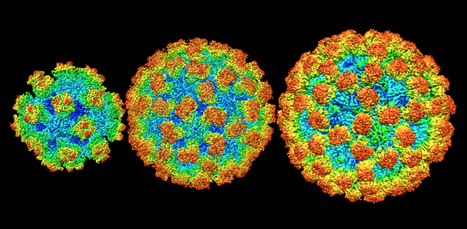


 Your new post is loading...
Your new post is loading...


